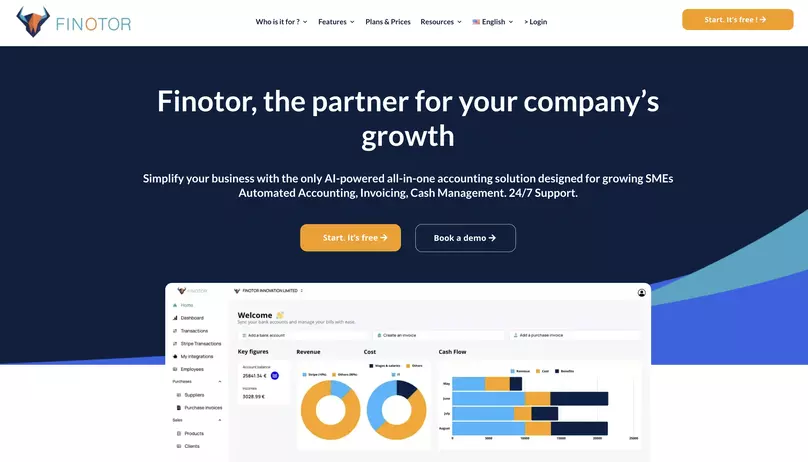Contents
- 1 Definition and importance of Financial Reporting Automation
- 2 Introduction of AI in Finance and Accounting operations
- 3 A. Reaping the Benefits of Automating Financial Reporting
- 4 B. Exploring the Impact on Cost Savings, Accuracy and Transparency
- 5 A. Introduction to Finotor as an All-in-One Solution
- 6 B. Unveiling Features and Functionality
- 7 A. Step-by-Step Guide to Implementing Finotor
- 8 B. Identifying Reporting that Can be automated
- 9 Why Finotor: Eyeing the Benefits
- 10 Experience the All-Inclusiveness
- 11 Implementing Finotor — A Step towards the Future
- 12 Training is Crucial
- 13 Monitoring and Adjustment
- 14 Preparing for the Challenge
- 15 Building a Foundation
- 16 Monitoring and Adjustments
- 17 Team Involvement
- 18 The Next Big Step
- 19 Make the Jump with Finotor
In an era propelled by smart technology, where corporate agility is synonymous with success, businesses must equip themselves with revolutionary tools to keep pace with the constantly evolving markets. In this spectrum, one game-changer that’s been stirring conversations in recent years is the Automation of Financial Reporting based on AI. Suitable for an array of industries, this advanced technology not just overhauls the whole framework of financial reporting, but also expedites decision-making processes.
Before we dive into the nitty-gritty of how AI has been revolutionising financial reporting automation, let’s take a moment to understand what we mean by these terms. Automation, as the name suggests, eliminates human intervention by mechanising processes traditionally carried out manually. When we apply automation to financial reporting – a vital process for any business, big or small – it implies shifting from manual ledger entries, statements generation, and report filing to a system that accomplishes all these tasks automatically.
Meshing AI with automation takes the game a notch higher. Here, Artificial Intelligence imitates human intelligence for tasks like learning, reasoning, problem-solving, perception, and language understanding. When applied to Automation of Financial Reporting, AI can learn from previous data, understand a pattern, solve discrepancies, and even alert the necessary personnel about potential mistakes, making the reporting process faster, more efficient and accrual-based.
In this comprehensive guide through the realm of Automation of Financial Reporting based on AI, we will take a deeper dive into the manifold benefits of this groundbreaking technology. Additionally, we shall also uncover some best practices that could guide businesses contemplating to initiate their journey in AI-driven Automation of Financial Reporting.
So, whether you’re a business owner, a part of a financial team, or an accountant grappling with financial reports’ complexities, this article aims to propound a groundbreaking approach that could streamline your business operations and help you climb ranks in your industry. Welcome to the future of financial reporting. It’s automated, accurate, timely, and driven by intelligence – artificial intelligence.
Embracing the Future: AI and Financial Reporting Automation
Today, we delve into a fast-evolving innovation that is swiftly revolutionizing accounting and finance spheres – the Automation of Financial Reporting based on AI.
Definition and importance of Financial Reporting Automation
Financial reporting automation, in essence, leverages technological prowess to automate the administration and evaluation of financial data. Imagine a world where instead of burning midnight oil scrutinizing spreadsheets and manually inserting data, finance professionals could harness the power of technology to expedite this process. Thrilling, isn’t it?
Introduction of AI in Finance and Accounting operations
Artificial Intelligence (AI), the tech-world darling, has further elevated this process. AI in financial reporting automation fosters amplified speed and precision, facilitating companies to formulate faster and better-informed business decisions. By integrating AI into finance operations, accounting becomes less about crunching numbers and more about strategic analysis and decision-making.
In this digital age, it is time for businesses and accounting teams to shake hands with automated financial reporting. By doing so, they can devote their time and efforts towards strategic tasks, boosting their overall productivity.
Stay tuned for more insights into the world of Automation of Financial Reporting based on AI as we delve deeper into the benefits it brings and best practices to effectively implement it.
2. Advancing Financial Efficiency: The Upsides of Automated Reporting
Discover the Unmatched Benefits of Automated Reporting
A. Reaping the Benefits of Automating Financial Reporting
Automation of Financial Reporting is the key to optimal business performance. By reducing the time and effort spent on manual data entry and analysis, businesses have the freedom to focus on more profit-generating activities. Automation guarantees substantial cost savings while enhancing productivity, an essential combo for the bottom line.
B. Exploring the Impact on Cost Savings, Accuracy and Transparency
Automated reporting cut costs and boost accuracy like no other. With less time wasted on manual data entry, your team can concentrate more on analyzing the data and implementing strategies. AI ensures accuracy, eliminating human errors that can distort the quality of data, leading to erroneous decisions. Added to these is the level of transparency automation brings. With the financial situation of a company laid bare in a comprehensible and easy-to-access fashion, transparency is assured.
3. Powering Finance with AI: The Best Tool Unveiled
Finotor – Revolutionizing Finance with AI
A. Introduction to Finotor as an All-in-One Solution
Welcome to the future of finance! Finotor, an AI-based accounting and financial analysis solution, is here to transform your finance department. With a vast array of tools specifically designed to streamline the financial process, from automating data entries to deciphering the complex financial trends, Finotor is your ‘all-in-one’ solution.
B. Unveiling Features and Functionality
Finotor’s features aim to simplify automated financial reporting. By transforming the traditionally manual tasks into automated solutions, Finotor helps you make informed decisions without burning endless hours. It means breaking free from manual work, leading to improved productivity, error elimination, and ultimately, improved profits.
4. Smoothening the Transition: Implementing Financial Automation Tools
Navigating Through The Transformation
A. Step-by-Step Guide to Implementing Finotor
Just as important as the choosing process is the implementation of Finotor. Start by identifying areas of your financial reporting that still adhere to manual procedures. Isolate these areas and use Finotor to automate them. Train your team, help them adapt and make everyone comfortable in the new functionality. Regular monitoring is crucial to identify the strengths and weaknesses, and so are necessary adjustments.
B. Identifying Reporting that Can be automated
Take a critical look at the areas of your financial reporting. Focus on tasks that require manual data entry, slowing down productivity. These are ripe for automation. Utilize AI to inject efficiency and accuracy in these areas.
3. Powering Finance with AI: The Best Tool Unveiled
Revealing the Game-Changer: Finotor
It’s high time we introduced you to Finotor – an all-in-one AI-powered accounting and financial analysis solution that takes Automation of Financial Reporting to the next level. Finotor is specifically crafted to simplify financial operations, from the automation of monotonous data entry to the sharp-eyed analysis of financial trends.
Aimed at leveraging the potency of AI in automating financial reporting process, Finotor helps companies unleash their true financial potential. Plus, it is considerably propitious for businesses mapped out to achieve financial efficiency and accuracy.
Why Finotor: Eyeing the Benefits
What sets Finotor apart from the traditional manual methods and merits its consideration? Think about it. Finotor is equipped to provide actionable insights from complex financial data. Not just that, these insights are served up faster than you could achieve manually, thereby enabling timely decision making.
Still not satisfied? Well, Finotor backs your financial journey with a power-packed mix of reliability and palpability. It is designed to reduce error-prone manual intervention, there by boosting the precision of financial reporting. A boon, considering the grave consequences that can result from inaccurate data reporting.
Experience the All-Inclusiveness
With Finotor, you get to experience a comprehensive suite of finance management tools seamlessly melded together. Whether it’s automated data entry, smart forecasting, risk analysis, or the much-feared tax computation, Finotor covers it all, positioning itself as your financial sidekick. And the best part? It’s all based on the marvel of AI and Automation.
Using advanced machine learning algorithms, Finotor not just simplifies your finance operations, but also makes them intelligent. It learns from your financial data to identify trends, preempt hurdles and provide strategic advice, making it deserving of a place in your finance department.
To sum up, Finotor is not just a finance automation tool. It’s an investment into the future of your business, offering a well-rounded solution that assists in driving your financial functions into the era of Automation of Financial Reporting based on AI.
4. Smoothening the Transition: Implementing Financial Automation Tools
Implementing Finotor — A Step towards the Future
To truly embrace the transformation brought about by the Automation of Financial Reporting based on AI, a structured implementation is key. If you’ve decided to adopt Finotor, an AI-based financial analysis tool, the journey begins by identifying the financial reports that can be automated. Look for areas where extensive manual data entry and analysis is slowing down your operation. Focusing on these areas first can result in significantly reduced errors and improved productivity.
Training is Crucial
Although advanced AI technology like Finotor is designed to streamline your financial reporting and offer massive benefits, its true potential can only be leveraged through a deeply engaged and well-trained team. Invest in comprehensive training, ensuring that everyone from your financial experts to the end-users understand the intricacies of the tool. This will help them adapt to the new technology, minimizing the resistance and disruption usually associated with significant operational changes.
Monitoring and Adjustment
After the system is in place, it’s crucial to monitor its performance regularly. No system is perfect from the get-go, and it’s likely you will hit a few bumps along the road. This is perfectly normal. What’s important is that you identify these areas of improvement and make tweaks and adjustments to the system accordingly. Don’t forget to also celebrate the successes and improvements Finotor brings, to keep the team motivated and invested in the tool.
Maintaining an open line of communication with your team during this phase is crucial. Your team’s feedback will give you valuable insights into the system’s effectiveness and areas for improvement. Remember, all members of your team – regardless of their position – should feel comfortable raising any concerns or issues with the new system.
Preparing for the Challenge
While it’s exciting to step into the future with AI-based financial reporting automation, it’s also perfectly normal to feel a little overwhelmed. The key to conquering these jitters is to approach the implementation in a structured, step-by-step manner. Remember, embracing Automation of Financial Reporting based on AI is not about making massive changes overnight, but rather about making gradual and consistent improvements over time.
Next, we’ll discuss some best practices to ensure the successful integration of this transformative technology into your business.
5. Adapting with Best Practices: Ensuring Successful Automation
Building a Foundation
Stepping up to Automation of Financial Reporting based on AI is a huge step forward, one that would revolutionize how you conduct business. A successful transition necessitates the adoption of robust practices, a transparent process, and an involved team.
Monitoring and Adjustments
The key to a successful transition lies in continuous monitoring of the effects of the change. Expect a learning curve. Be patient. Make adjustments in line with the insights you draw from the performance of your automated process.
Team Involvement
Keep your team in the loop throughout the advancement to automation. Their feedback, relayed from different parts of your business operations, would be instrumental in adjusting the automated system to your unique business needs.
Final Words: Taking Action
The Next Big Step
The world is moving towards automation. It’s time to take action and get on board. In the era of instant access to information and rapid decisions, Automation of Financial Reporting based on AI is the best solution to handle the growing complexity in finance and accounting tasks.
Make the Jump with Finotor
To make the most of your business, outmaneuver your competitors and spend as little time as possible on accounting, it’s time to embrace automation. This shift allows you to focus your attention & resources on real value creation.
Conclusion
As we pivot further into the digital landscape, a reality shines through – innovation, efficiency, and accuracy are at the heart of thriving businesses. The integration of technologies like artificial intelligence and automation is steadily transforming practices across all industry sectors, and financial reporting isn’t an exception. From saving time and cutting cost to increasing reliability and efficiency, the benefits of automation in financial reporting are vast.
Imagine this: instead of gathering and analyzing data manually, your financial team could leverage a system that does all the heavy lifting, minus the errors. The time saved translates to a more productive organization while ensuring compliance with regulatory requirements. This transformative shift from manual to automated processes – Automation of Financial Reporting based on AI, is what today’s business owner needs to empower their finance team and streamline operations.
Automation ensures consistency and speed, reducing the chances of discrepancies while large volumes of financial data are being processed. Moreover, by integrating AI with your company’s financial reporting, you can predict market trends, enhance data analysis, and reinforce decision-making processes. Leveraging AI can effectively help in managing financial risks by predicting potential financial problems and providing timely alerts.
The benefits of implementing automation of financial reporting based on AI are evident. However, it is critical to follow the best practices for maximum efficiency. These may include engaging professionals for the integration process, providing necessary training to the staff, choosing the right software, ensuring regular software updates, and maintaining a secure network for data protection.
In conclusion, Automating Financial Reporting with the help of AI is not just a trend, but a strategic necessity in today’s fast-paced and competitive business landscape. It is a game-changer for business owners, financial teams, and accountants alike, paving the way towards streamlined operations and sound financial decision-making.
Just as the adage goes, time is money; saving time through automation means saving money and transforming that saved time into strategic thinking and future planning. Embracing this technological advancement is no longer an option; it’s an imperative for every responsible and forward-looking business on the journey of growth and sustainability. Thus, make sure you onboard this digital train soon before your competitors leave you at the station.










